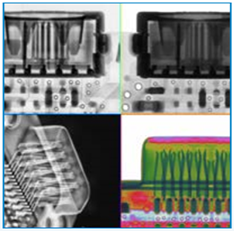Application case of X-RAY detection of fuse defects
Release time:2024-04-19Publisher:Jeenoce
X-RAY fuse detection is a non-destructive testing technique that uses X-rays to penetrate an object and receive transmitted X-rays on the other side. By detecting the intensity distribution of transmitted X-rays, the internal structure and defects of the object can be inferred. In the process of fuse manufacturing, X-RAY testing is widely used to detect internal defects and quality control of fuses.
A fuse is an electrical protection component used to cut off current in the event of overload or short circuit in a circuit, thereby protecting the circuit and equipment. Therefore, the quality and reliability of fuses are crucial for the normal operation of electrical systems. The application of X-RAY detection technology can greatly improve the quality and reliability of fuses, reduce defect rates, and improve production efficiency.
When conducting X-ray testing, it is necessary to place the fuse on the testing table of the X-ray machine, and then emit X-rays through the fuse through the X-ray machine. During the process of X-rays penetrating a fuse, if there are defects inside the fuse, such as pores, inclusions, cracks, etc., the transmission intensity of X-rays will change. The X-ray machine receives transmitted X-rays and converts them into digital signals. Through computer processing and analysis, the internal structure and defect information of the fuse can be obtained.

The advantages of X-RAY fuse detection lie in its non-destructive, high-precision, and high efficiency. Firstly, X-RAY detection will not cause any damage to the fuse, therefore it will not affect the electrical performance of the fuse. Secondly, X-RAY testing can accurately detect internal defects in fuses, including small pores and inclusions, thereby ensuring the quality and reliability of the fuse. Finally, X-RAY detection can quickly complete a large number of detection tasks and improve production efficiency.
In addition to X-RAY testing, there are other testing methods that can be used for quality control of fuses, such as visual inspection, mechanical performance testing, etc. However, these methods often have some limitations, such as visual inspection can only detect surface defects, while mechanical performance testing can only detect the mechanical properties of fuses and cannot detect internal defects. Therefore, X-RAY detection, as a comprehensive and accurate detection method, plays an irreplaceable role in the manufacturing process of fuses.
In practical applications, X-RAY detection of fuses still needs to pay attention to some issues. Firstly, the selection and configuration of the X-ray machine need to be adjusted based on factors such as the size, shape, and material of the fuse to ensure the best detection effect. Secondly, attention should be paid to radiation safety during the detection process to avoid harm to operators and the surrounding environment. Finally, the interpretation and analysis of X-RAY test results need to be carried out by professional technicians to ensure accuracy and reliability.
In summary, X-RAY fuse detection is an important non-destructive testing technique that can greatly improve the quality and reliability of fuses, reduce defect rates, and improve production efficiency. In practical applications, attention should be paid to the selection and configuration of X-ray machines, radiation safety, and interpretation and analysis of detection results to ensure detection effectiveness and safety.

